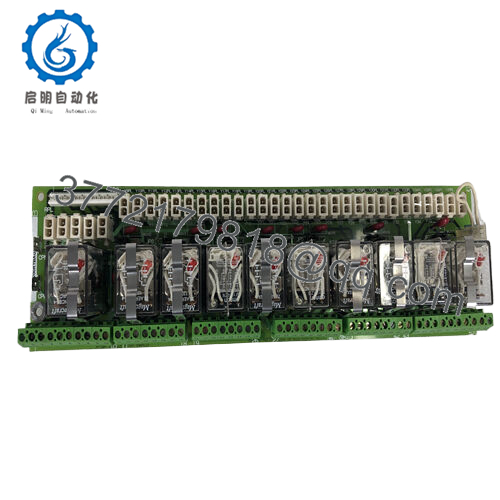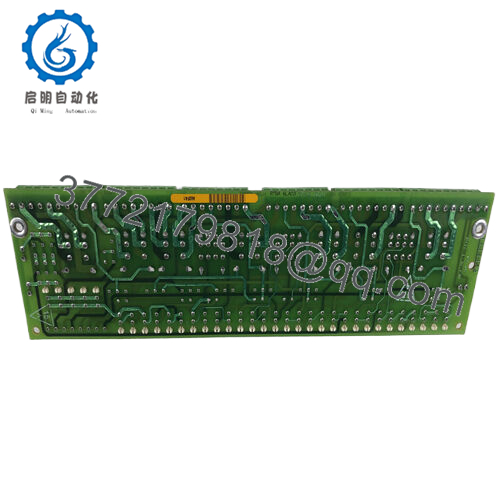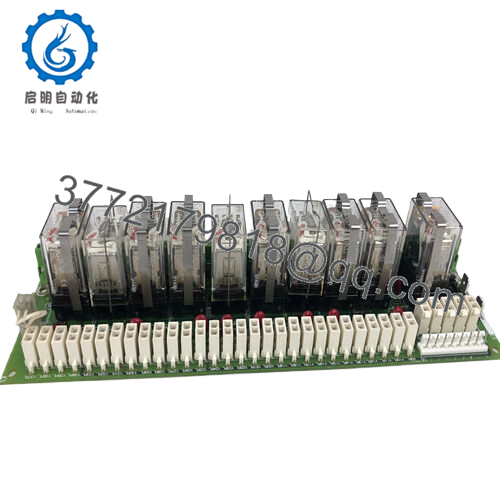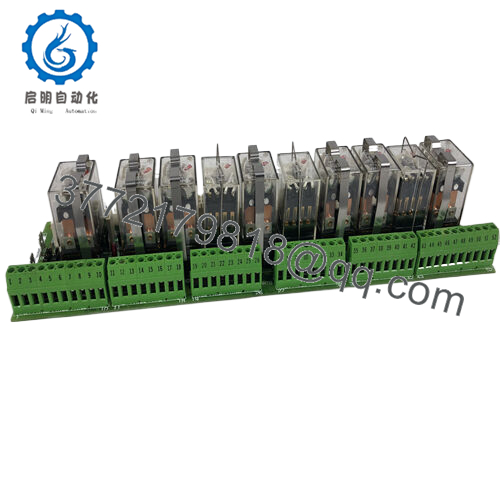Description
What This Product Solves
In the high-voltage crucible of industrial automation, particularly for excitation systems in turbine generators, the specter of unreliable relay actuation can unravel the delicate balance of power delivery, where unbuffered coil voltages lead to erratic contactor throws, field flash failures, and the cascading faults that compromise process control stability and grid synchronization. Engineers commissioning or maintaining EX2000 setups in power plants, hydropower stations, or industrial co-generation facilities frequently grapple with the pitfalls of mismatched relay boards—plagued by DC-only coils in AC-dominant environments, limited remote drivability, and vulnerability to transient surges—resulting in delayed startup sequences, inadvertent trips, and the diagnostic deep dives that idle megawatts for days, inflating outage costs and eroding reliability metrics in 24/7 baseload operations. Imagine a steam turbine exciter in a utility boiler feed, where relay chatter from voltage incompatibility misfires field breakers, stalling synchronization and risking overflux that damages rotors, or a hydro generator in peak demand, where remote actuation lag from unconfigurable coils delays load sharing, destabilizing the grid and triggering blackouts in interconnected networks.
The GE DS200RTBAG3AFB steps in as a pivotal relay terminal board for the EX2000 excitation control system, engineered to restore system stability by providing versatile, AC-compatible relay interfaces that bridge controller commands to high-power actuators. It zeroes in on the user’s imperative for high reliability in modular I/O architectures, featuring ten relays (K20-K29) driven directly from plot relays or remotely via user logic, with a mix of 115 VAC and DC coil options to match diverse excitation topologies, ensuring I/O signal robustness against the electromagnetic fury of generator bays. Essential in retrofit paths—like upgrading legacy Mark V excitation cabinets with EX2000 compatibility or scaling redundant field circuits in multi-unit plants—this board mitigates the fault ripples from coil mismatches, enabling seamless integration with <T> core processors for fault-tolerant operation. For searchers probing “industrial automation excitation relay boards” or “process control turbine terminal modules,” the GE DS200RTBAG3AFB illuminates viable upgrades, aligning relay ratings with dynamic field demands to sidestep overprovisioned contactors or bespoke coil converters.
Its design anticipates the grit of generator floors—Berg-type jumpers for field-configurable modes and coated PCB for dust/condensation resilience. This reframes the engineering narrative from relay roulette to inherent robustness, particularly in setups demanding continuous S1 duty without derates. In process control realms where I/O latency equates to load loss, the GE DS200RTBAG3AFB redefines dependability, channeling ingenuity toward predictive synchronization over post-fault firefighting, and forging the relay resilience for resilient, responsive operations that endure the surge of surging equipment and escalating energy imperatives.
How the Product Works & Fits into a System
Excitation ecosystems thrive when relay boards act as the resolute relays between logic layers and load levers, but coil versatility is vital to vanquish voltage variances. The GE DS200RTBAG3AFB relays as a terminal board in the EX2000 series, interfacing ten electromechanical relays (K20-K26 at 115 VAC coils, K27-K29 at 125 VDC) that latch/unlatch on command from the <T> plot relays or remote user bits, sourcing 10 A contacts rated for 120/240 VAC loads with arc suppression via RC snubbers, while Berg jumpers (JP1-JP10) configure modes like latching or pulse operation, and status LEDs illuminate coil energization for visual verification in run-time. Operating in slave mode, it buffers inputs via opto-isolated drivers (24 VDC logic) to rebuff 1500 V isolation, ensuring loop integrity in transient-heavy bays.
In the broader I/O architecture, this board mounts via standoffs in EX2000 cabinets adjacent to the <T> core and power bridge, connecting via 50-pin ribbon cables (TYRAK, TYRBK) for command handoffs and screw terminals for field wiring (TB1-TB3 for relay commons), syncing with Mark V/VIe controllers over serial bus for deterministic polling in multi-board chains. Redundancy layers through dual-coil options and fault relays compliant with IEEE C37.90 for SIL2 safety, meshing with DCS for excitation trending in redundant topologies. Diagnostics stream via <T> polling, logging contact health to rack memory for forensic retrieval in scaled sims.
- DS200RTBAG3AFB
- DS200RTBAG3AFB
For the commissioning engineer, it’s pragmatically plugged: jumper JP1 for AC mode, affix to the chassis with ESD guards, then param relay maps in ToolboxST for auto-test—commissioning condenses to an hour, eluding the arcane coil swaps of legacy RTBAs. Position it at the actuation edge in the stack, downstream of excitation logic and upstream of field breakers, where it transmutes bit bangs into bold bursts—like vesting flashover commands for preemptive field buildup. The GE DS200RTBAG3AFB transcends toggling; it transmutes it, nurturing networks that ascend from raw relays to refined reckoning, where terminal tenacity ignites the inference between intent and impeccable industrial implementation in the ceaseless cadence of coordinated control.
Technical Highlights Summary (Table)
| Specification | Details |
|---|---|
| Model Number | DS200RTBAG3AFB |
| Brand | GE (EX2000 Series) |
| Type | Relay Terminal Board |
| Input Voltage | 115 VAC / 125 VDC (coils) |
| Operating Temp Range | -40°C to +70°C |
| Mounting Style | Chassis Standoffs |
| Dimensions | 250 mm x 150 mm x 50 mm |
| Weight | 1.2 kg |
| Interface/Bus | 50-pin Ribbon / Screw Terminals |
| Compliance | CE, IEEE C37.90, RoHS |
| Supported Protocols | Serial Bus (Mark V/VIe) |
| Typical Power Draw | 15 W (coil excitation) |
Real-World Benefits
Incorporating the GE DS200RTBAG3AFB fortifies your excitation stack with relay resilience that quells coil chaos into coherent commutation, especially in multi-unit generators where voltage versatility and isolation are the bulwark against blackout. Tailored for the relentless rhythm of S1 continuous excitation, its 115 VAC relays sustain 10 A contacts without chatter across 240 VAC loads, ensuring performance consistency that clamps throw times to <50 ms over transient tides—pivotal for hydro governors where actuation overshoot might miss sync windows, but here they hit harmony that halves hunt times and reclaims ramp rates for refined reactivity. This robustness ripples to redundancy rewards, as jumper-configurable modes preempt phantom picks in remote drivings, enabling bolder bus loads without the conservative cutoffs that curb capacity in under-bonded boards.
The board’s chassis-centric ethos eases the collaborative calculus, bonding to EX2000 bays with ribbon-ready routing that obviates custom harness hassles, curtailing engineering overhead in phased proliferations where relay sprawl strains sync speeds—crews redirect days to sim-based tuning that refines latching logics. Maintenance morphs into measured mindfulness, with LED litanies and <T>-logged faults beaming breach beacons to benches for anticipatory amends, protracting probe periods to semi-annual serenity and sanctioning remote re-jumps that nix 75% of run rifts, diverting deftness to deltas like predictive contact profiling for coil permutations.
Across deployment decades, the GE DS200RTBAG3AFB affirms affinity via IEEE-rated resilience that defies corrosive climes, conjoined with the 15 W whisper that whittles watt woes in cabinet confines, easing ecological equities in expansive excitations. Engineered to eclipse expansion entropy, it diminishes the dilemma of differential deficits, bestowing the breadth to braid bonuses—from remote relay rings to 10-point quilts—actualizing as the nexus that crystallizes commutation into clout, where relay rigor begets the bedrock of brilliant, boundless industrial acuity in the crucible of ceaseless coordination.
Typical Use Cases
The GE DS200RTBAG3AFB energizes excitation in environments of exactitude and expanse, commencing with steam turbines for field flashing in utility boilers. In process control environments steeped in steam swirls and rotor rumbles, it actuates 10 relays for breaker bridging at 115 VAC, where harsh thermal throbs from exciters buffet bonds but bolster critical system uptime—bedrock for cycles syncing 500 MW hourly, forestalling flash failures that could compromise coil currents. Fast data cycles entwine with <T> cores for command cascades that sustain sync sojourns, sustaining specs without spec-killing spikes.
In hydropower, the GE DS200RTBAG3AFB drives AVR relays amid water whirls and wicket gate wobbles, channeling remote user bits for load sharing in 10-point sims. Continuous uptime underpins generation gusts, as its isolation preempts noise nips in multi-unit manifolds, meshing with governors for voltage vectors that dodge deviation drifts. Performance pinnacles in humid halls, yet it upholds I/O signal sanctity, mitigating mis-syncs in hydro-harnessing harnesses.
For co-generation, used in power plants for gas turbine tie-ins or afar—the GE DS200RTBAG3AFB pulses protection relays in combined cycles, braving exhaust eddies and fuel flurries to sequence startups. Harsh inertial swings from shaft spins test its tenacity, fusing with excitation scripts for field fidelity that meets grid quals. Traversing steam’s surge, hydro’s hum, and co-gen’s chorus—the GE DS200RTBAG3AFB fuses high reliability with refined reckoning, sustaining sectors where relay rigor illuminates impeccable iteration.
Compatible or Alternative Products
DS200RTBAG3A – Base variant without F revision for legacy EX2000 compatibility in simpler field circuits.
DS200RTBAG3AEB – Enhanced board with additional DC coils for hybrid AC/DC excitation in multi-voltage setups.
DS200RTBAG4A – Upgraded terminal with higher current ratings for demanding AVR applications in large hydro.
DS200RTBAG5A – Modern Mark VIe equivalent for Ethernet-enabled remote actuation in networked plants.
IS200RTBAG3A – Speedtronic counterpart for turbine control in gas/steam hybrid generations.
IS215UCVEM_P1 – Complementary excitation module for voltage regulation pairing with RTBA boards.
VME-7750 – GE VME relay card for rack-based expansions in custom excitation cabinets.
Bently Nevada 3500/92 – Alternative communication gateway for vibration-relay integration in monitoring.
Setup Notes & Maintenance Insights
As you chassis-mount the GE DS200RTBAG3AFB in your EX2000 cabinet, a compatibility cull clears coil clouds: affirm the <T> core firmware via ToolboxST for relay mapping (v10.0+), as mismatches muffle to 24 VDC—update if below in sim. Slot seating summons ESD sheaths and a pin probe on 50-pin ribbons (TYRAK); prior pops breed bias bleeds, so swab with iso and torque standoffs to 1.0 Nm for flush fits that dodge vibration voids. Relay wiring via TB1-TB3 demands polarity probes—connect 115 VAC coils to K20-K26 with 14 AWG cables, then param jumpers JP1-J10 in the controller for auto-latch, tweaking modes if throw overs 50 ms in sim. Thermal trace in env sim: emulate cabinet flow at 0.3 m/s to vet -40°C to +70°C span, retrofitting shields if sims spike in unvented enclosures with clustered heat sources.
Sustaining the GE DS200RTBAG3AFB thrives on timely taps, not triage toils. Bi-weekly, interrogate LEDs for coil flickers—amber ambers cue contact oops, sim’d with a load gen to confirm 10 A tolerance. Quarterly, reseat ribbons in low-humidity lulls to combat connector creep; a loupe spots corrosion, but a dielectric grease dab preserves IP20 poise without conductance creeps. Annual diagnostic deep-dive—cycling a full relay sim in run mode—benchmarks against baseline throws; lags over 5 ms intimate arc erosion, refreshed via <T> re-param without board yank. Firmware affinity with the <T> core averts actuation aches; propagate via serial during sim-only slots, attesting with a contact sweep. These deliberate drills, drawn from field folios, perpetuate the board’s 10 A mettle, channeling calibration to creative calibrations from corrective crusades.





 WhatsApp: +86 16626708626
WhatsApp: +86 16626708626 Email:
Email:  Phone: +86 16626708626
Phone: +86 16626708626


